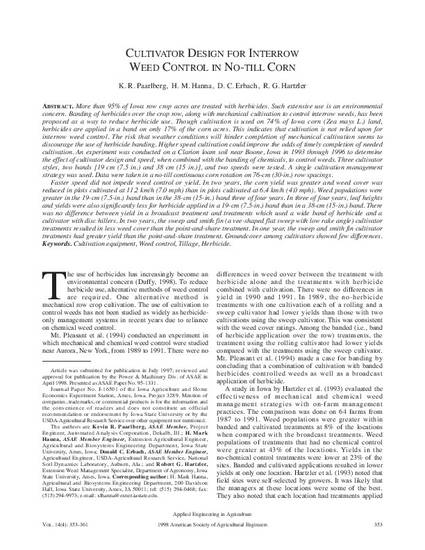
More than 95% of Iowa row crop acres are treated with herbicides. Such extensive use is an environmental concern. Banding of herbicides over the crop row, along with mechanical cultivation to control interrow weeds, has been proposed as a way to reduce herbicide use. Though cultivation is used on 74% of Iowa corn (Zea mays L.) land, herbicides are applied in a band on only 17% of the corn acres. This indicates that cultivation is not relied upon for interrow weed control. The risk that weather conditions will hinder completion of mechanical cultivation seems to discourage the use of herbicide banding. Higher speed cultivation could improve the odds of timely completion of needed cultivation. An experiment was conducted on a Clarion loam soil near Boone, Iowa in 1993 through 1996 to determine the effect of cultivator design and speed, when combined with the banding of chemicals, to control weeds. Three cultivator styles, two bands [19 cm (7.5 in.) and 38 cm (15 in.)], and two speeds were tested. A single cultivation management strategy was used. Data were taken in a no-till continuous corn rotation on 76-cm (30-in.) row spacings.
Faster speed did not impede weed control or yield. In two years, the corn yield was greater and weed cover was reduced in plots cultivated at 11.2 km/h (7.0 mph) than in plots cultivated at 6.4 km/h (4.0 mph). Weed populations were greater in the 19-cm (7.5-in.) band than in the 38-cm (15-in.) band three of four years. In three of four years, leaf heights and yields were also significantly less for herbicide applied in a 19-cm (7.5-in.) band than in a 38-cm (15-in.) band. There was no difference between yield in a broadcast treatment and treatments which used a wide band of herbicide and a cultivator with disc hillers. In two years, the sweep and smith fin (a vee-shaped flat sweep with low rake angle) cultivator treatments resulted in less weed cover than the point-and-share treatment. In one year, the sweep and smith fin cultivator treatments had greater yield than the point-and-share treatment. Groundcover among cultivators showed few differences.
Available at: http://works.bepress.com/mark_hanna/85/

This article is from Applied Engineering in Agriculture 14 (1998): 353–361, doi:10.13031/2013.19394.